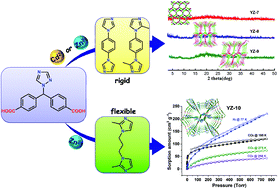Structure modulation from unstable to stable MOFs by regulating secondary N-donor ligands†
Abstract
Four new Zn(II)/Cd(II)-based metal–organic frameworks (MOFs), namely {[Cd(tmdb)(bib)0.5]·solvents}n (YZ-7, YZ stands for the initials of the author Yong-Zheng Zhang), {[Cd(tmdb)(bmib)0.5]·solvents}n (YZ-8), {[Zn2(tmdb)2(bmib)]·solvents}n (YZ-9) and {[Zn2(tmdb)2(bmip)2]·solvents}n (YZ-10) have been solvothermally synthesized by using a semi-rigid ligand, 4,4′-(H-1,2,4-triazol-1-yl)methylene-dibenzoic acid (H2tmdb), and a series of secondary bis-imidazole ligands (bib = 1,4-bis(1H-imidazol-1-yl)benzene, bmib = 1,4-bis(2-methyl-1H-imidazol-1-yl)benzene, and bmip = 1,3-bis(2-methyl-1H-imidazol-1-yl)propane). By tuning the flexibility of the auxiliary ligands, these MOFs could be modulated from unstable (YZ-7–YZ-9) to stable (YZ-10) frameworks. Therefore, the gas adsorption properties of YZ-10 are further studied. Interestingly, it shows excellent CO2 selective uptake over CH4 and N2. At 298 K, both selectivities of CO2/CH4 and CO2/N2 show increasing trends and significantly reach 133.2 and 19.9 at 1 atm, respectively. Also, YZ-10 shows uncommon H2 selective uptake over N2 at 77 K. Moreover, the luminescence properties of YZ-8–YZ-10 were studied in the solid state at room temperature.



 Please wait while we load your content...
Please wait while we load your content...